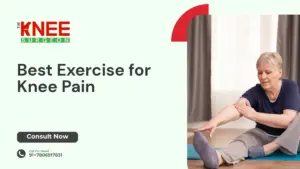Knee pain often creeps in after long hours of sitting, climbing stairs, or even during daily walks, making simple activities feel challenging. Caring for your knee health is vital to staying active and pain-free. This blog shares the best exercise for knee pain, helping you strengthen your joints, ease discomfort, and move with confidence again.
Why Exercise is Important for Knee Health
- Regular exercise plays a crucial role in maintaining healthy, pain-free knees. When the muscles around the joint become weak or stiff, even simple actions like walking, bending, or climbing stairs can cause discomfort. Engaging in the best exercise for knee pain helps improve joint flexibility, strengthens supporting muscles, and enhances overall stability.
- Consistent movement keeps the knee joint well-lubricated, reducing stiffness and preventing cartilage wear over time. Performing knee strengthening exercises for knee pain—such as leg raises, step-ups, and wall sits—builds muscle support around the knees, easing pressure on the joint and lowering the risk of future injuries.
- Incorporating the best knee strengthening exercises into your daily routine not only eases existing knee pain but also supports long-term joint health and stability. With regular practice, you can enjoy smoother movement, improved balance, and stronger, more resilient knees for everyday activities.
Lower-Body Stretches for Knee Pain
Stretching your lower body helps to ease stiffness, loosen tight muscles, and improve joint flexibility around the knees. When combined with strength work, these stretches make a great complement to the best exercise for knee pain routines. Below are some effective knee pain relief exercises in stretch form — do each gently and hold for 20–30 seconds.
Hamstring Stretch (Seated or Standing):
- Sit on the floor or the edge of a chair, extend one leg straight, and gently lean forward to feel a stretch behind your knee. This is an effective hamstring strain exercise to relieve tension.
- Alternatively, stand and place one heel on a low stool, then hinge forward at the hips, keeping your back straight, to safely stretch the hamstrings and support recovery from a hamstring strain.
Quadriceps Stretch (Standing or Lying)
- Stand and grab your ankle behind you, pulling your heel toward your buttock, keeping knees close.
- Or lie on your side and do the same to stretch the front of the thigh.
Calf Stretch (Wall or Step)
- Face a wall, place hands on it, step one foot back, keep heel flat and lean forward.
- Alternatively, stand on the edge of a step with heels hanging off and lower down gently.
IT Band Stretch / Side-Lying Leg Cross
- Lie on one side, cross the top leg over and bring the knee toward the opposite arm to stretch the outside of the thigh.
- You’ll feel the stretch along the outer hip and knee area.
Hip Flexor Stretch / Lunge Stretch
- Step one foot forward into a low lunge, pushing the hips gently forward (keep the back knee soft).
- This opens the front hip, which reduces strain on the knees.
Inner Thigh Stretch (Butterfly or Side Lunge)
- Sit and bring the soles of your feet together (butterfly), press knees gently down.
- Or do a side lunge, shifting weight to one side while keeping the other leg straight to feel an inner thigh stretch.
These stretches, when done regularly in tandem with knee strengthening exercises for knee pain, help build flexibility and resilience. Always move gently, stop if you feel sharp pain, and complement stretching with strengthening routines to support knee health.
Strengthening Exercises for Knee Pain
Building strength in the muscles surrounding your knees is key to reducing pain, enhancing stability, and preventing future injuries. Combining gentle stretches with knee pain relief exercises can improve mobility and support overall joint health. Adding the best exercise for knee pain to your daily routine helps develop stronger, more resilient knees naturally. Here are some effective best knee strengthening exercises you can do at home:
- Straight Leg Raises: Lie flat on your back with one leg bent and the other extended straight on the floor. Slowly lift the straight leg to match the height of the bent knee, hold for a moment, and then lower it gently. This exercise strengthens the front thigh muscles (quadriceps) without putting pressure on your knees, making it an excellent knee pain relief exercise.
- Wall Sits: Stand with your back against a wall and slide down until your knees form a 90-degree angle. Hold for 10–30 seconds, then slowly rise. Wall sits engage the thigh muscles, improve knee stability, and enhance overall joint strength.
- Step-Ups: Using a low step or sturdy platform, step up with one leg, then bring the other leg up before stepping down slowly. Step-ups strengthen the quadriceps, hamstrings, and glutes, helping reduce strain on the knees during daily activities.
- Hamstring Curls: Stand upright and slowly bend one knee, bringing your heel toward your glutes. Pause briefly, then lower the leg back down with control. Hamstring curls target the muscles at the back of your thighs, helping balance leg strength and reducing strain on the knee during everyday movements.
- Quad Sets: Sit with legs straight and tighten your thigh muscles, pressing the back of your knee gently into the floor. Hold for 5–10 seconds, then release. Quad sets are simple yet highly effective knee strengthening exercises for managing knee pain.
- Calf Raises: Stand with feet shoulder-width apart and slowly raise your heels off the ground, then lower them back down. Calf raises strengthen the lower legs, improve ankle stability, and support proper knee alignment.
- Side-Lying Leg Lifts: Lie on your side with legs stacked. Lift the top leg slowly, then lower it with control. This exercise targets the hip abductors and outer thighs, helping stabilize the knee and support smooth, pain-free movement during walking and daily activities.
Incorporating these strengthening exercises for knee pain alongside regular stretching can greatly reduce discomfort, improve mobility, and maintain long-term knee health. Consistency, proper form, and gentle progression are key to achieving the best results.
How to Tell If You’re Exercising at the Right Level
- Exercising for knee health can be highly beneficial, but it’s important to ensure you’re performing the best exercise for knee pain at the correct intensity. Too little effort may not strengthen the muscles enough, while too much can strain your knees and slow recovery.
- A key indicator is how your knees and surrounding muscles feel during and after exercise. Mild muscle fatigue or a gentle stretch is normal, but sharp or worsening pain is a warning sign to stop or reduce intensity. When performing knee strengthening exercises for knee pain, you should feel your muscles working without causing joint discomfort.
- Another way to gauge the right level is by monitoring your range of motion. You should be able to move smoothly through exercises without locking your knees or experiencing unusual stiffness. Tracking progress over time, such as increased repetitions or longer hold times, can also help ensure you’re challenging your muscles safely.
- Finally, pay attention to your body’s signals and make adjustments as necessary. Pairing proper technique with gradual increases in intensity allows your knees to get stronger while avoiding injury, ensuring the exercises remain both effective and safe.
Exercises to Avoid If You Have Knee Pain
- Not all exercises are suitable for individuals with knee pain, and performing the wrong movements can worsen discomfort or cause injury. Even when following the best exercise for knee pain routines, it’s important to know which activities to skip to protect your joints.
- High-impact exercises like running on hard surfaces, jumping, or plyometric workouts can place excessive stress on the knees and should be avoided until your joints are stronger. Similarly, deep squats or lunges with heavy weights can strain the ligaments and cartilage, making them unsuitable for beginners or those experiencing persistent pain.
- Twisting movements, sudden pivots, or high-resistance leg machines may also aggravate knee discomfort. Instead, focus on controlled, low-impact exercises, such as cycling, swimming, or gentle resistance band routines, which are safer alternatives while still promoting strength.
- Even when performing the best knee strengthening exercises, it’s important to maintain proper form and avoid overloading the joint. Listening to your body, taking breaks, and gradually increasing intensity ensures that you strengthen your knees safely without risking further injury.
- By knowing which exercises to avoid, you can complement your best exercise for knee pain plan effectively, improving mobility and building stronger, pain-free knees over time.
When to See a Doctor or Physiotherapist
- While performing exercises can greatly improve knee health, there are situations where professional guidance is essential. If you experience persistent pain, swelling, locking, or instability in your knee despite following the best exercise for knee pain, it’s time to consult a specialist. Early evaluation helps prevent further damage and ensures a faster, safer recovery.
- For expert care, Dr. Vijay Kumar Sohanlal, recognized as the best knee pain doctor in India, is highly recommended. With decades of experience in joint replacement surgeries, he is skilled in both total and partial knee replacements. Dr. Sohanlal follows a patient-first philosophy, emphasizing pain-free recovery and precision-driven surgeries using advanced implant techniques. His compassionate care and excellent surgical outcomes make him a trusted name in orthopedics for both simple and complex knee cases.
- Seeing a doctor or physiotherapist like Dr. Sohanlal is crucial when exercises alone do not relieve discomfort or when symptoms worsen. Combining professional guidance with carefully supervised knee strengthening exercises ensures safe recovery, improved mobility, and long-term knee health. Prioritizing expert care can help you maintain strong, pain-free knees while preventing further complications.
Conclusion
Maintaining strong and flexible knees is essential for staying active and reducing discomfort. Incorporating the best exercise for knee pain into your daily routine can significantly improve joint stability, enhance mobility, and prevent further injury. By combining gentle stretches, targeted strengthening exercises, and proper guidance, you can manage pain effectively and support long-term knee health. Consistency, proper technique, and listening to your body are key to achieving lasting results and enjoying pain-free movement every day.





